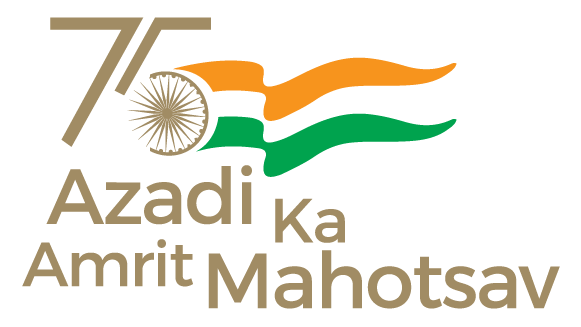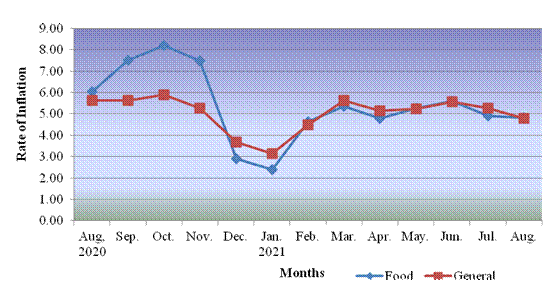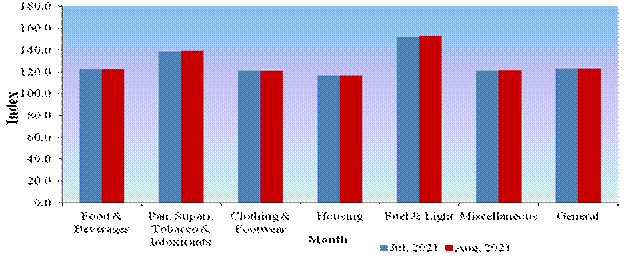Thursday 30 September 2021
Consumer Price Index for Industrial Workers (2016=100) – August, 2021
Ministry of Labour & Employment

Consumer Price Index for Industrial Workers (2016=100) – August, 2021
The All-India CPI-IW for August, 2021increased by 0.1 point and stood at 123.0 (one hundred twenty three). On 1-month percentage change, it increased by 0.16 per cent with respect to previous month compared to an increase of 0.60 per cent recorded between corresponding months a year ago.
Labour Bureau, an attached office of the Ministry of Labour & Employment, has been compiling Consumer Price Index for Industrial Workers every month on the basis ofretail prices collected from 317 markets spread over 88 industrially important centres in the country. The index is compiled for 88 centres and All-India and is released on the last working day of succeeding month. The index for the month of August, 2021 is being released in this press release.
The maximum upward pressure in current index came from Miscellaneousgroup contributing 0.08 percentage points to the total change. At item level, Cow Milk, Dairy Milk, Mustard Oil, Palm Oil, Soyabean Oil, Almond, Sugar-white, Tea Leaf,Cooking Gas, Hospital/Nursing Home Charges, Petrol for Vehicle, Toilet Soap, etc. are responsible for the rise in index. However, this increase was largelychecked byRice, Eggs (Hen), Fish Fresh, Poultry/Chicken, Apple, Banana, Guava, Mausami, Bitter Gourd, Cucumber, Drum Stick, French Beans, Lady’s Finger, Onion, Potato, etc. putting downward pressure on the index.
At centre level,Ludhianarecorded maximum increaseof 3.5points followed by Jalpaiguri, Guwahati, Jalandhar and Munger-Jamalpur with 2.9 points, 2.6 points, 2.1 points and 2.0 points respectively.Among others,11 centres observed an increase between 1 to 1.9 pointsand 33 centres between 0.1 to 0.9 points.On the contrary, Coonoorrecorded a maximum decrease of 5.5 points followed by Tirunelveli with 2.2 points.Among others, 5 centres observed a decline between 1 to 1.9 points and 26 centres between 0.1 to 0.9 points. Rest of 6 centres remained stationary.
Year-on-year inflation for the month stood at 4.79 per cent compared to 5.27per cent for the previous month and 5.63 per cent during the corresponding month a year before. Similarly, Food inflation stood at 4.83per cent against 4.91per cent of the previous month and 6.06per cent during the corresponding month a year ago.
Shri D.PS. Negi, Principal Advisor, Ministry of Labour & Employment said that All-India Consumer Price Index for Industrial Workers (2016=100) for August, 2021 increased to 123.0 points compared to 122.8 points for July, 2021.
Shri Negi further said that the increase observed in index is mainly due to items like Cow Milk, Dairy Milk, Mustard Oil, Palm Oil, Soyabean Oil, Almond, Sugar-white, Tea Leaf, Cooking Gas, Hospital/Nursing Home Charges, Petrol for Vehicle, Toilet Soap, etc. which experienced an increase in prices. General inflation for August, 2021 went down to 4.79 per cent compared to 5.27 per cent of previous month. Food inflation also moderated to 4.83 per cent from 4.91 per cent in the previous month.
Y-o-Y Inflation based on CPI-IW (Food and General)

All-India Group-wise CPI-IW for JulyandAugust,2021
Sr. No. | Groups | July, 2021 | August, 2021 |
I | Food & Beverages | 122.4 | 122.3 |
II | Pan, Supari, Tobacco & Intoxicants | 138.9 | 139.1 |
III | Clothing & Footwear | 120.8 | 121.0 |
IV | Housing | 116.8 | 116.8 |
V | Fuel & Light | 152.0 | 153.1 |
VI | Miscellaneous | 121.1 | 121.3 |
| General Index | 122.8 | 123.0 |
CPI-IW: Groups Indices

The next issue of CPI-IW for the month of September, 2021 will be released on Friday,29th October, 2021
Wednesday 29 September 2021
Sunday 26 September 2021
Friday 24 September 2021
Women and the Post































































